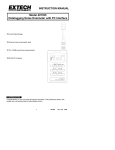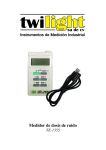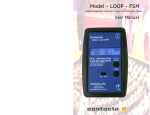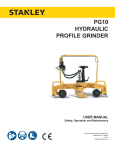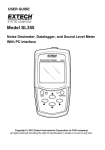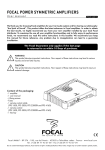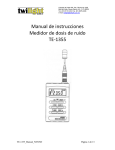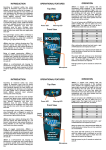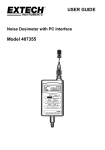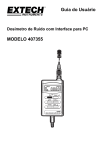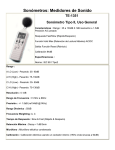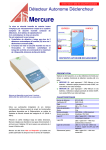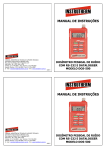Download Personal Noise Exposure Model: TES-1354
Transcript
Personal Noise Exposure Model: TES-1354 INSTRUCTION MANUAL TABLE OF CONTENTS 1. GENERAL DESCRIPTION....................................................... 1 2. PRINCIPLE OF MEASURING ACCUMULATED NOISE EXPOSURE .......................................................................................1 3. FEATURES ................................................................................ 2 4. SPECIFICATION....................................................................... 2 5. NOMENCLATURE AND FUNCTIONS .................................. 5 6. DISPLAY PANEL DESCR IPTION ......................................... 7 7. MEASUREMENT PREPARATION ......................................... 8 8. OPERATING INSTRUCTIONS................................................ 8 9. CALIBRATION PROCEDURES ............................................10 10.MODE SETTING .....................................................................11 11.USING THE PERSONAL NOISE EXPOSURE METER............ 11 12.MAINTENANCE ..................................................................... 12 1. GENERAL DESCRIPTION Thanks for your selecting Personal Noise Dosemeter. To ensure that you can get the most from it we recommend that you read the manual carefully before use. The personal noise dosimeter is test equipment to evaluate the noise condition of working environment by measuring the accumulated noise exposure. With this test data, company can ensure the related noise regulation is followed or decide whether or not to apply certain noise reduction action to avoid the acoustic trauma and noise-induced hearing loss occurs to the working personnel. 2. PRINCIPLE OF MEASURING ACCUMULATED NOISE EXPOSURE DOSE is a parameter used to quantify noise exposure measured during a period, in turns of % noise exposure relative to 90dBA for 8 hours. i.e. 100% DOSE = 90dBA for 8 hours This is known as the Criterion. Other criterion are available such as 100% DOSE = 85dBA for 8 hours to meet legislation in different countries. If the person stayed in this environment for 4 hours, he would receive 50%DOSE. Also if the noise level was say 93dBA, 3dB higher, a 100% DOSE would be accumulated in only 4 hours, The above example is for a dosemeter with 3dB Exchange Rate, where a 3dB increase in sound level corresponds to a doubling energy. A dosemeter with 5dB Exchange Rate is also, available where the sound must increase by 5dB to double the dose as required to meet noise legislation in some countries. 1 3. FEATURES (1) Measures personal accumulated noise exposure in a period with the unit of % noise dose. (2) 70 〜 140 dBA sound level measurement. (3) Accurate, easy to use and understand. 4. SPECIFICATION Standard applied : ANSI S1.25-1991 A-weighting ISO-1999 BS 6402: 1983 Microphone: 1/2 inch electret condenser microphone, 31-inch cable. Display : Liquid Crystal Display Noise DOSE Range: .01 to 9999 % DOSE Criterion Level: Selectable 80 , 84 , 85 , 90dB Threshold Level: Selectable 70 〜 90dB, 1dB step Exchange Rate: Selectable 3 , 4 , 5 , 6dB High Level Detector: 115dBA Peak Flag: 140dBA 2 Measuring Range of Sound Level: 70-140dBA Accuracy : ± 1.5dB Frequency Weighting: A Frequency Response: 20Hz 〜 10KHz Time Constant : F(FAST) ; S(SLOW) Operating Temperature & Humidity: 0 〜 50 ℃ ( 32 to 122 ℉ ) , 10 〜 90%RH Storage Temperature & Humidity: -10 〜 60 ℃ 10 〜 75%RH ( 14 to 140 ℉ ), Battery : 4pcs. size AAA alkaline batteries Battery Life: about 40 hours Size: 106(L) × 60(W) × 34(H)mm 4.2(L) × 2.4(W) × 1.3(H)inch Weight: Approx. 350g (including batteries) Accessories: Instruction manual, Carrying case, Screwdriver, batteries 3 CE Certification: CE-mark indicates compliance EMC Directive Safety EN61010-1 (1993) and IEC 1010-1 (1990): Safety requirements for electrical equipment for measurement, control and laboratory use EMC Emission EN50081-1 (1992): Generic emission standard. Part 1 : Residential, commercial and light industry EN50081-2 (1993): Generic emission standard. Part 2: Industrial environment CISPR22 (1993): Radio disturbance characteristics of information technology equipment. Class B Limits FCC Rules, Part 15: Complies with the Limits for a Class B digital device EMC Immunity EN50082-1 (1992): Generic immunity standard. Part 1: Residential, commercial and light industry RF immunity implies that sound level indications of 70dB or greater will be affected by no more than ± 1.5dB EN 50082-2 (1995): Generic immunity standard. Part 2: Industrial environment RF immunity implies that sound level indications of 70dB or greater will be affected by no more than ±1.5dB 4 5. NOMENCLATURE AND FUNCTIONS Fig 1 5 Microphone Display panel Power switch Instantaneous of sound pressure level Press the key to starts accumulating noise exposure. Press the key and hold 3 seconds to stops accumulating noise exposure. DOSE is a parameter used to quantify noise exposure measured in a period with the unit of % noise exposure . The total time means accumulated running time, the colon will blink and display will show hours and minutes. CAL screw Battery cover 11 Carrying clip 6 6. DISPLAY PANEL DESCR IPTION Fig 2 DOSE sign Displayed when a sound pressure level is over 140dBA Run time for DOSE measurement SPL sign Displayed when a sound pressure level is over 115dBA Battery energy condition indicator Fast or Slow response time constant Indication of noise exposure is now been accumulated Measurement interruption of noise exposure 7 7. MEASUREMENT PREPARATION (1) Load Battery Unscrew the big screw on the back of the unit and remove the carrying clip. Insert four AAA-size alkaline batteries. Note: Make sure the battery polarity is installed as indicated. (2) Battery replacement When the batteries is down, a low battery mark flash in the display. Batteries should be replaced with new ones. (3) The battery symbol shows the remaining capacity the battery by the number of segments. The relative of the remaining capacity and the number of segments are show as below. Four segments --- over 84% capacity remaining Three segments --- over 66% capacity remaining Two segments --- over 25% capacity remaining One segments --- over 11% capacity remaining Empty battery --Instrument specification not guaranteed. 8. OPERATING INSTRUCTIONS Power the instrument on by pressing the key. When you switch on this instrument, you will see all of the ), annunciator, DOSE sign and the set Criterion level ( Threshold level ( ), Exchange rate ( ) information. 8 The displayed function have the following meanings: (1) Instantaneous of sound pressure level Press the SPL Key, start measure acoustic pressure. Measuring range : 70-140dBA If measure value is below 68.0dBA the will show - - - - dBA. (no value) display (2) Noise exposure measured in a period Press the DOSE key then press the START key to start measuring accumulated noise exposure. The display will show annunciators. If you want to read the the %DOSE and accumulated running time, press the TIME Key and the display will show the TIME annunciator. The colon will blink and display hours and minutes. You can switch between DOSE mode and run time mode at anytime. If you want to stop measuring accumulated noise exposure, press the STOP key and hold for 3 seconds and the annunciator will also vanish. Note: When the START key is pressed, the previously measured data of DOSE and run time will be cleared. (3) Pause / Continue When the STOP key is pressed, the measuring of noise exposure will be interrupted in amid way and the measurement data is held and the display show the PAUSE annunciator. If the START key is pressed, the measurement will be resumed from that point, the PAUSE annunciator will vanish on the display. In pause mode, measurement of instantaneous sound pressure level mode can still operate. When the instrument is to be out of use. Please, press the key and hold until the display counts down from - - - 3 to - - - 0 and then blanks, power down procedures. 9 9. CALIBRATION PROCEDURES Using a standard acoustic calibrator 1. Make the following switch settings. Display : SPL (dBA) Time constant: S SLOW 2. Insert the microphone housing carefully into the insertion hole of the calibrator. 3. Turn on the switch of calibrator and adjust the CAL screw of the instrument, until the level display will indicate the desired level. Note: Our products are all well calibrated before shipment. Recommended calibrator cycle is one year. Fig 3 10 10. MODE SETTING Start with the power off mode. Press the ↵ (enter) Key and hold, then press the (power) key to switch the instrument into setting mode. Press or key to select parameter. S : SLOW time constant F : FAST time constant Criterion Level ( Threshold Level ( ): Selectable 80, 84, 85, 90dB ): Selectable from 70 〜 90dB, 1dB step Exchange Rate ( ): Selectable 3, 4, 5, 6dB Press or key to adjust parameter. Press ↵ (enter) key﹐to leave this setting mode. 11. USING THE PERSONAL NOISE EXPOSURE METER To use instrument to measure personal noise exposure, the procedure is as follows: (1) Power the instrument on by pressing the key. (2) Check the battery status. If the battery level is low, please replace the batteries. 11 (3) Fit the instrument to the user by clipping it to the breast pocket on shirt or the belt etc. The microphone must be clipped to the shirt collar as close as possible to the wearer’s ear. The cable must be routed so as not to impede the working movements of the user. (4) Press the START key, the instrument will begin to accumulate noise exposure. (5) In order to get reliable test data the user must keep his typical working day pattern and must not shout into the microphone to change the test result and it is best to run noise exposure testing over several days to achieve better average data. (6) At the end of wording day, one can read the accumulated noise exposure by pressing the STOP key and hold for 3 seconds. 12. MAINTENANCE (1) Service and Repair Noise Dose Meter The Noise Dose Meter is designed and constructed to provide many years of reliable operation. However, if a fault occurs that impairs the dosemeter is correct function, then remove the batteries to prevent risk of further damage. For more information about preventing or identifying faults or damage to your dosemeter is, please read the other sections of this chapter. For repair, contact your local dealer. 12 (2) Care, Cleaning and Storage The Noise Dose Meter is a delicate precision instrument. When handling, storing, or cleaning your instrument, please take note of the following precautions: (a). Storing the Instrument Keep the instrument in a dry place. For long-term storage, remove the batteries Do not exceed storage temperature limits of -10 to +60 ℃ ( -14 to +140 ℉ ). (b). Cleaning the Instrument If the instrument casing becomes dirty, then wipe it with a cloth lightly dampened with water. Do not use abrasive cleansers or solvents. Do not allow moisture to enter the microphone, connectors, or casing. (c) . Handling the instrument Do not try to remove the microphone gird, you can easily damage the microphone in this way. Do not attempt to open the instrument. There are no user-serviceable parts inside. If you think your instrument requires service, then please contact your dealer. Do not allow the instrument to get wet. Never mix different makes or types of battery. Never mix charged and discharged batteries. Do not allow fully discharged batteries to remain inside the instrument Protect the instrument from impact. Do not drop it. Transport it in the supplied shoulder bag. 13















